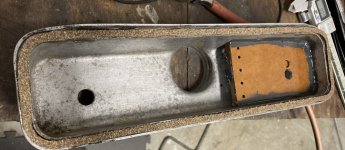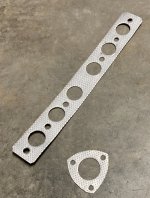Out of interest, how is your crankcase vent set up? I have a standard Reniflard unit venting to air. Your smell is quite a puzzle!The exhaust is not leaking at the manifold exit. I sealed the area above the radiator and around the top of the right side cardboard. I sealed the heater core to the cardboard. I also slowed down the fan (adjusted my voltage convertor) since I was running it a good bit faster than it would be on 6v. It might be a little better, but I am not sure. It has been unseasonably warm here recently, but I will get a better test next week when it will be cold. I might also seal the top of the cardboard on the left. to keep a bit less engine compartment smell from the radiator intake. It would be interesting to know exactly what the airflow does in the engine compartment. I suspect that air circles around the edge of the radiator anywhere it can.
The heater duct is new - I had a rubber duct, but changed it to aluminum just in case the rubber was the problem. It did not make a difference. I also need to make sure there is not any petrol seeping out on the top of the gas tank. There are no drips or stains on the side of the tank, but the tiniest amount would make the heater smell terrible.

You are using an out of date browser. It may not display this or other websites correctly.
You should upgrade or use an alternative browser.
You should upgrade or use an alternative browser.
4cv Sofica heater smells bad
- Thread starter Stan W
- Start date
I have it venting from the valve cover into the outlet of the air filter assembly (basically the carburetor inlet). I made a baffle inside the top of the valve cover similar to that used on later Dauphines. I sealed up the oil filler cap so it would not vent there, but I noticed that the o-ring that seals it has swelled a bit and moved out of place. A very small amount of crankcase gases could escape there, but probably not much. It doesn't leak too much at the flywheel end, so probably not getting lots of fumes out that way either.


I thought you'd probably have done that!I have it venting from the valve cover into the outlet of the air filter assembly (basically the carburetor inlet). I made a baffle inside the top of the valve cover similar to that used on later Dauphines. I sealed up the oil filler cap so it would not vent there, but I noticed that the o-ring that seals it has swelled a bit and moved out of place. A very small amount of crankcase gases could escape there, but probably not much. It doesn't leak too much at the flywheel end, so probably not getting lots of fumes out that way either.
View attachment 139385
I could have worded it better.....
Sorry John, growing old is compulsory, but growing up is optional 
I don't have a leak in the exhaust below the manifold. Since I still have a problem, my best guess is that I have a leak where the manifold is fastened to the head. The gasket material I used may not be thick enough. One side has a metal backing, the other does not. I may try making another gasket and using some sort of sealant. Would the spray on copper coat sealants work for this application?


I honestly don't know. I'll be interested to hear the results if and when you try them! Is the manifold surface flat? Silly question as you are bound to have tested it. I guess "our" standard cast manifolds are more rigid than the ones you got in the States.I don't have a leak in the exhaust below the manifold. Since I still have a problem, my best guess is that I have a leak where the manifold is fastened to the head. The gasket material I used may not be thick enough. One side has a metal backing, the other does not. I may try making another gasket and using some sort of sealant. Would the spray on copper coat sealants work for this application?
View attachment 199723
I would make sure first that both mating faces are straight and flat.
That gasket looks interesting. I notice the fasteners are lined up, which in my mind is not giving a very rigid join. Is there any other support to the manifold(s)? What do the manifolds look like? It seems odd there's only six ports.
I would think there is no need for any sealant. At least I don't think I've ever seen sealant used for either intake or exhaust manifolds.
That gasket looks interesting. I notice the fasteners are lined up, which in my mind is not giving a very rigid join. Is there any other support to the manifold(s)? What do the manifolds look like? It seems odd there's only six ports.
I would think there is no need for any sealant. At least I don't think I've ever seen sealant used for either intake or exhaust manifolds.
The US cars got the Autobleu 6-branch manifold not the conservatively restrictive standard cast item.I would make sure first that both mating faces are straight and flat.
That gasket looks interesting. I notice the fasteners are lined up, which in my mind is not giving a very rigid join. Is there any other support to the manifold(s)? What do the manifolds look like? It seems odd there's only six ports.
I would think there is no need for any sealant. At least I don't think I've ever seen sealant used for either intake or exhaust manifolds.
I think I was more surprised by the number of ports because it means two of them must be serving two cylinders each. Are these intake or exhaust? (I would guess intake and I would also guess it's port #2 and #5).
Ports were siamesed on the Ventoux motor, not uncommon in that era - best common example being BMC „A“ series engineI think I was more surprised by the number of ports because it means two of them must be serving two cylinders each. Are these intake or exhaust? (I would guess intake and I would also guess it's port #2 and #5).
Has been done for years - 1920‘s Austin seven was the same. Led to many happy hours with the die grinder, tubing and brazing torch for the racing/special building fraternity
Andrew
Thank you. I take it we are talking about the intake ports?Ports were siamesed on the Ventoux motor, not uncommon in that era - best common example being BMC „A“ series engine
Has been done for years - 1920‘s Austin seven was the same. Led to many happy hours with the die grinder, tubing and brazing torch for the racing/special building fraternity
Andrew
That must be it!!Maybe it is a failure in the ignitor system, you are detecting the unburnt fuel!
According to the advertising the 4cv heater should be delivering flames, keeping those four horses happy.
I am fairly certain I checked the manifold and head surfaces to make sure they were flat - it would be unusual if I did not. The US cars got the autobleu from about 1956 to 1959. After that they used the standard cast manifold. The gaskets for the cast manifolds are much thicker that the material I have. Some of the manifolds did not have the studs all lined up in the center. It may have been just the Gordini/Floride motors.
BMC "B" series engines had siamesed intake ports and one siamesed exhaust port for cylinders two and three. Cylinders one and four each had their own exhaust port.
I have FINALLY solved the problem of the stinky Sofica! 

The cause was old oily dirt on the heater core and the Sofica filter.
I cleaned the air side of the heater core when restoring the car, but not enough. A few weeks ago I decided to clean the heater air filter (the screen wire thing). It did not look dirty, but smelled bad. It took countless cycles of cleaner application, soaking, and rinsing to get it clean. The heater stink was much less. The plastic heater housing had been cleaned sufficiently during restoration.
I changed the anti-freeze a few days ago and decided to clean the core more thoroughly. The purple cleaner just didn't seem to be doing the job, so I cleaned the fins with carburetor cleaner. Lots of black dirt came off. After several rounds of carburetor cleaner, I went back the the purple cleaner the get the remainder of the residue off. I now have a good heater without the stink.
I think the cause of the oily dirt was a worn engine and a clogged breather combined with missing cardboard panels.
The cause was old oily dirt on the heater core and the Sofica filter.
I cleaned the air side of the heater core when restoring the car, but not enough. A few weeks ago I decided to clean the heater air filter (the screen wire thing). It did not look dirty, but smelled bad. It took countless cycles of cleaner application, soaking, and rinsing to get it clean. The heater stink was much less. The plastic heater housing had been cleaned sufficiently during restoration.
I changed the anti-freeze a few days ago and decided to clean the core more thoroughly. The purple cleaner just didn't seem to be doing the job, so I cleaned the fins with carburetor cleaner. Lots of black dirt came off. After several rounds of carburetor cleaner, I went back the the purple cleaner the get the remainder of the residue off. I now have a good heater without the stink.
I think the cause of the oily dirt was a worn engine and a clogged breather combined with missing cardboard panels.
Great news. Now you know there isn't some odd ongoing emission too! Best wishes for Christmas and the New Year.I have FINALLY solved the problem of the stinky Sofica!
The cause was old oily dirt on the heater core and the Sofica filter.
I cleaned the air side of the heater core when restoring the car, but not enough. A few weeks ago I decided to clean the heater air filter (the screen wire thing). It did not look dirty, but smelled bad. It took countless cycles of cleaner application, soaking, and rinsing to get it clean. The heater stink was much less. The plastic heater housing had been cleaned sufficiently during restoration.
I changed the anti-freeze a few days ago and decided to clean the core more thoroughly. The purple cleaner just didn't seem to be doing the job, so I cleaned the fins with carburetor cleaner. Lots of black dirt came off. After several rounds of carburetor cleaner, I went back the the purple cleaner the get the remainder of the residue off. I now have a good heater without the stink.
I think the cause of the oily dirt was a worn engine and a clogged breather combined with missing cardboard panels.
